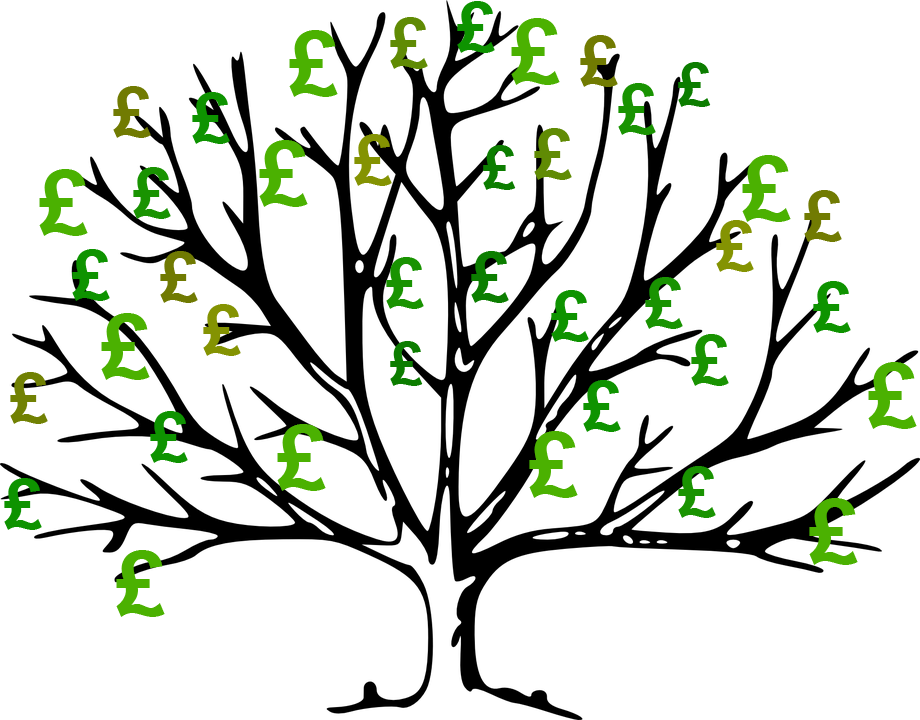 Is there a ‘magic money tree’? Is it desirable for central banks to create money to finance government deficits?
Is there a ‘magic money tree’? Is it desirable for central banks to create money to finance government deficits?
The standard thinking of conservative governments around the world is that creating money to finance deficits will be inflationary. Rather, governments should attempt to reduce deficits. This will reduce the problem of government expenditure crowding out private expenditure and reduce the burden placed on future generations of having to finance higher government debt.
If deficits rise because of government response to an emergency, such as supporting people and businesses during the Covid-19 pandemic, then, as soon as the problem begins to wane, governments should attempt to reduce the higher deficits by raising taxes or cutting government expenditure. This was the approach of many governments, including the Coalition and Conservative governments in the UK from 2010, as econommies began to recover from the 2007/8 financial crisis.
 ‘Modern Monetary Theory‘ challenges these arguments. Advocates of the theory support the use of higher deficits financed by monetary expansion if the money is spent on things that increase potential output as well as actual output. Examples include spending on R&D, education, infrastructure, health and housing.
‘Modern Monetary Theory‘ challenges these arguments. Advocates of the theory support the use of higher deficits financed by monetary expansion if the money is spent on things that increase potential output as well as actual output. Examples include spending on R&D, education, infrastructure, health and housing.
Modern monetary theorists still accept that excess demand will lead to inflation. Governments should therefore avoid excessive deficits and central banks should avoid creating excessive amounts of money. But, they argue that inflation caused by excess demand has not been a problem for many years in most countries. Instead, we have a problem of too little investment and too little spending generally. There is plenty of scope, they maintain, for expanding demand. This, if carefully directed, can lead to productivity growth and an expansion of aggregate supply to match the rise in aggregate demand.
Government deficits, they argue, are not intrinsically bad. Government debt is someone else’s assets, whether in the form of government bonds, savings certificates, Treasury bills or other instruments. Provided the debt can be serviced at low interest rates, there is no problem for the government and the spending it generates can be managed to allow economies to function at near full capacity.
The following videos and articles look at modern monetary theory and assess its relevance. Not surprisingly, they differ in their support of the theory!
Videos
Articles
- Modern monetary theory: the rise of economists who say huge government debt is not a problem
The Conversation, John Whittaker (7/7/20)
- Modern Monetary Theory: How MMT is challenging the economic establishment
ABC News, Gareth Hutchens (20/7/20)
- What is Modern Monetary Theory and is it THE answer?
Sydney Morning Herald, Jessica Irvine (2/7/20)
- MMT: what is modern monetary theory and will it work?
MoneyWeek, Stuart Watkins (14/7/20)
- MMT: the magic money tree bears fruit
MoneyWeek, Stuart Watkins (17/7/20)
- Modern Monetary Theory is no Magic Money Tree
Adam Smith Institute, Matt Kilcoyne (20/5/20)
- “Modern Monetary Theory” Goes Mainstream
Forbes, Nathan Lewis (10/7/20)
- How Boris Johnson’s Conservatives have become Magic Money Tree huggers
The Scotsman, Bill Jamieson (16/7/20)
- Ignore the impacts of debt-fuelled stimulus at your peril
Livewire, David Rosenbloom (14/7/20)
- Modern Monetary Theory, explained
Vox.com, Dylan Matthews (16/4/19)
Questions
- Compare traditional Keynesian economics and modern monetary theory.
- Using the equation of exchange, MV = PY, what would a modern monetary theorist say about the effect of an expansion of M on the other variables?
- What is the role of fiscal policy in modern monetary theory?
- What evidence might suggest that money supply has been unduly restricted?
- When, according to modern monetary theory, is a rising government deficit (a) not a problem; (b) a problem?
- Is there any truth in the saying, ‘There’s no such thing as a magic money tree’?
- Provide a critique of modern monetary theory.
 Boris Johnson gave a speech on 30 June outlining his government’s approach to recovery from the sharpest recession on record. With the slogan ‘Build, build, build’, he said that infrastructure projects were the key to stimulating the economy. Infrastructure spending is a classic Keynesian response to recession as it stimulates aggregate demand allowing slack to be taken up, while also boosting aggregate supply, thereby allowing recovery in output while increasing potential national income.
Boris Johnson gave a speech on 30 June outlining his government’s approach to recovery from the sharpest recession on record. With the slogan ‘Build, build, build’, he said that infrastructure projects were the key to stimulating the economy. Infrastructure spending is a classic Keynesian response to recession as it stimulates aggregate demand allowing slack to be taken up, while also boosting aggregate supply, thereby allowing recovery in output while increasing potential national income.
A new ‘New deal’
He likened his approach to that of President Franklin D Roosevelt’s New Deal. This was a huge stimulus between 1933 and 1939 in an attempt to lift the US economy out of the Great Depression. There was a massive programme of government spending on construction projects, such as hospitals, schools, roads, bridges and dams, including the Hoover Dam and completing the 113-mile Overseas Highway connecting mainland Florida to the Florida Keys. Altogether, there were 34 599 projects, many large-scale. In addition, support was provided for people on low incomes, the unemployed, the elderly and farmers. Money supply was expanded, made possible by leaving the Gold Standard in 1934.
 There was some debate as to whether the New Deal could be classed as ‘Keynesian’. Officially, the administration was concerned to achieve a balanced budget. However, it had a separate ’emergency budget’, from which New Deal spending was financed. According to estimates by the Federal Reserve Bank of St Louis, the total extra spending amounted to nearly 40% of US GDP as it was in 1929.
There was some debate as to whether the New Deal could be classed as ‘Keynesian’. Officially, the administration was concerned to achieve a balanced budget. However, it had a separate ’emergency budget’, from which New Deal spending was financed. According to estimates by the Federal Reserve Bank of St Louis, the total extra spending amounted to nearly 40% of US GDP as it was in 1929.
By comparison with the New Deal, the proposals of the Johnson government are extremely modest. Mostly it amounts to bringing forward spending already committed. The total of £5 billion is just 0.2% of current UK GDP.
Focusing on jobs
A recent report published by the Resolution Foundation, titled ‘The Full Monty‘, argues that as the Job Retention Scheme, under which people have been furloughed on 80% pay, is withdrawn, so unemployment is set to rise dramatically. The claimant count has already risen from 1.2m to 2.8m between March and May with the furlough scheme in place.
 Policy should thus focus on job creation, especially in those sectors likely to experience the largest rise in unemployment. Such sectors include non-food retail, hospitality (pubs, restaurants, hotels, etc.), public transport, the arts, entertainment and leisure and a range of industries servicing these sectors. What is more, many of the people working in these sectors are young and low paid. Many will find it difficult to move to jobs elsewhere – partly because of a lack of qualifications and partly because of a lack of alternative jobs. The rising unemployment will raise inequality.
Policy should thus focus on job creation, especially in those sectors likely to experience the largest rise in unemployment. Such sectors include non-food retail, hospitality (pubs, restaurants, hotels, etc.), public transport, the arts, entertainment and leisure and a range of industries servicing these sectors. What is more, many of the people working in these sectors are young and low paid. Many will find it difficult to move to jobs elsewhere – partly because of a lack of qualifications and partly because of a lack of alternative jobs. The rising unemployment will raise inequality.
The Resolution Foundation report argues that policy should be focused specifically on job creation.
Policy makers should act now to minimise outflows from the hard-hit sectors – a wage subsidy scheme or a National Insurance cut in those sectors would reduce labour costs and discourage redundancies. Alongside this, the Government must pursue radical action to create jobs across the country, such as in social care and housing retrofitting, and ramp up support for the unemployed.
Dealing with hyteresis
The economy is set to recover somewhat as the lockdown is eased, but it is not expected to return to the situation before the pandemic. Many jobs will be lost permanently unless government support continues.
Even then, many firms will have closed and others will have reassessed how many workers they need to employ and whether less labour-intensive methods would be more profitable. They may take the opportunity to consider whether technology, such as AI, can replace labour; or they may prefer to employ cheap telecommuters from India or the Philippines rather than workers coming into the office.
Policies to stimulate recovery will need to take these hysteresis effects into account if unemployment is to fall back to pre-Covid rates.
Videos
Articles
- Coronavirus: Boris Johnson pledges ‘new deal’ to build post-virus
BBC News (30/6/20)
- Boris Johnson hails his economic plan as a new ‘New Deal.’ Try ‘small deal’ instead
MarketWatch, Pierre Briançon (30/6/20)
- Boris Johnson announces state-led post-coronavirus relaunch
Financial Times, George Parker, Jim Pickard and Chris Giles (30/6/20)
- How does Boris Johnson’s ‘new deal’ compare with Franklin D Roosevelt’s?
The Guardian, Richard Partington (30/6/20)
- Coronavirus: Ministers urged to stave off ‘second wave’ of unemployment with major job creation plan
PoliticsHome, Matt Honeycombe-Foster (29/6/20)
- Biggest job creation package in peacetime needed to deflect increase in UK unemployment, think tank reports
Independent, Alan Jones (29/6/20)
- UK needs ‘biggest-ever peacetime job creation plan’ to stop mass unemployment
The Guardian, Richard Partington (29/6/20)
- The International Labour Organization was founded after the Spanish flu – its past lights the path to a better future of work
The Conversation, Huw Thomas, Frederick Harry Pitts and Peter Turnbull (17/6/20)
- Seven charts on the coronavirus jobs market
BBC News, By Lora Jones and Daniele Palumbo (16/6/20)
- Covid, hysteresis, and the future of work
Vox, Richard Baldwin (29/5/20)
- The economy won’t snap back after Covid-19
Financial Times, Tim Harford (5/6/20)
- Addressing The Covid-19 Shock -Keeping People In Work And Businesses Afloat
Forbes, Linda Yueh (20/3/20)
- Cutting labour taxes brings back the jobs lost to COVID-19
Vox, Christian Bredemeier, Falko Juessen and Roland Winkler (28/6/20)
Report
Questions
- What are the arguments for and against substantial increased government expenditure on infrastructure projects?
- Should the UK government spend more or less on such projects than the amount already pledged? Justify your answer.
- What are the arguments for and against directing all extra government expenditure towards green projects?
- Look through the Resolution Foundation report and summarise the findings of each of its sections.
- What are the arguments for and against directing all extra government expenditure towards those sectors where there is the highest rate of job losses?
- What form could policies to protect employment take?
- How should the success of policies to generate employment be measured?
- What form does hysteresis play on the post-Covid-19 labour market? What four shocks mean that employment will not simply return to the pre-Covid situation?
 Three international agencies, the IMF, the European Commission and the OECD, all publish six-monthly forecasts for a range of countries. As each agency’s forecasts have been published this year, so the forecasts for economic growth and other macroeconomic indicators, such as unemployment, have got more dire.
Three international agencies, the IMF, the European Commission and the OECD, all publish six-monthly forecasts for a range of countries. As each agency’s forecasts have been published this year, so the forecasts for economic growth and other macroeconomic indicators, such as unemployment, have got more dire.
The IMF was the first to report. Its World Economic Outlook, published on 14 April, forecast that in the UK real GDP would fall by 6.5% in 2020 and rise by 4% in 2021 (not enough to restore GDP to 2019 levels); in the USA it would fall by 5.9% this year and rise by 4.7% next year; in the eurozone it would fall by 7.5% this year and rise by 4.7% next.
The European Commission was next to report. Its AMECO database was published on 6 May. This forecast that UK real GDP would fall by 8.3% this year and rise by 6% next; in the USA it would fall by 6.5% this year and rise by 4.9% next; in the eurozone it would fall by 7.7% this year and rise by 6.3% next.
The latest to report was the OECD on 10 June. The OECD Economic Outlook was the most gloomy. In fact, it produced two sets of forecasts.
The first, more optimistic one (but still more gloomy than the forecasts of the other two agencies) was based on the assumption that lockdowns would continue to be lifted and that there would be no second outbreak later in the year. This ‘single-hit scenario’ forecast that UK real GDP would fall by 11.5% this year and rise by 9% next (a similar picture to France and Italy); in the USA it would fall by 7.3% this year and rise by 4.1% next; in the eurozone it would fall by 9.1% this year and rise by 6.5% next.
The second set of OECD forecasts was based on the assumption that there would be a second wave of the virus and that lockdowns would have to be reinstated. Under this ‘double-hit scenario’, the UK’s GDP is forecast to fall by 14.0% this year and rise by 5.0 per cent next; in the USA it would fall by 8.5% this year and rise by 1.9% next; in the eurozone it would fall by 11.5% this year and rise by 3.5% next.
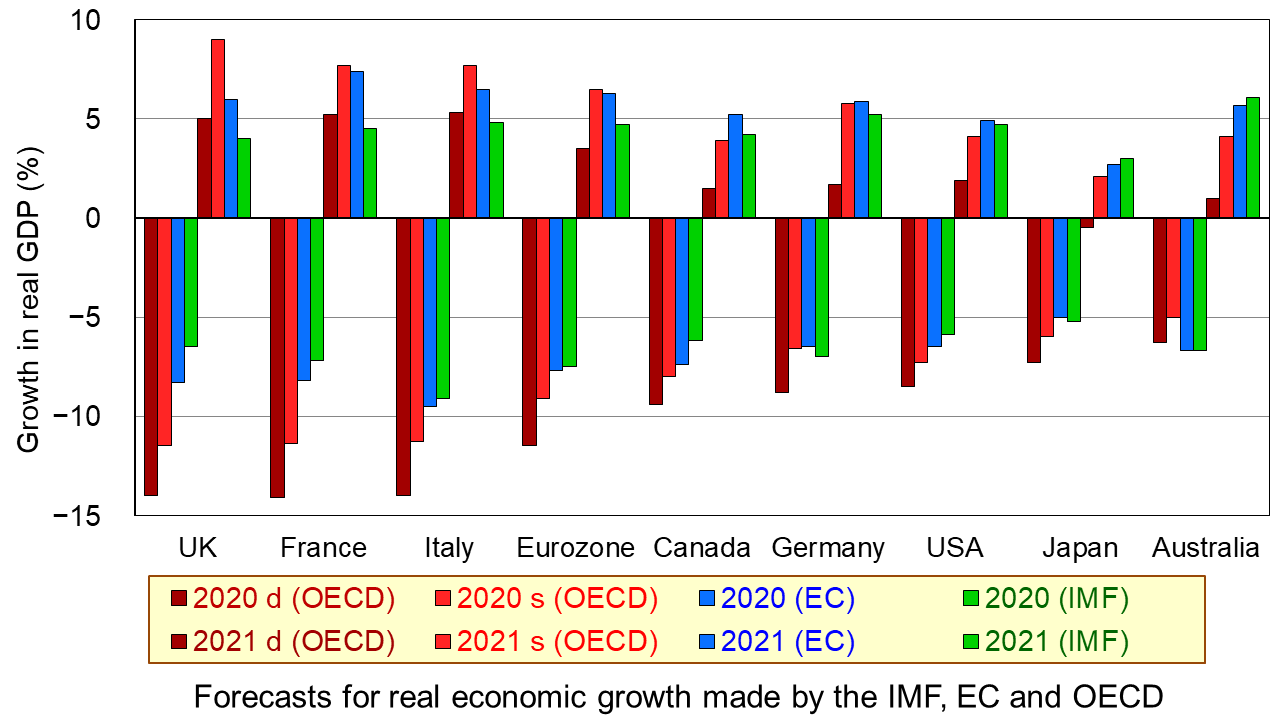
The first chart shows the four sets of forecasts (including two from the OECD) for a range of countries. The first four bars for each country are the forecasts for 2020; the other four bars for each country are for 2021. (Click here for a PowerPoint of the chart.)
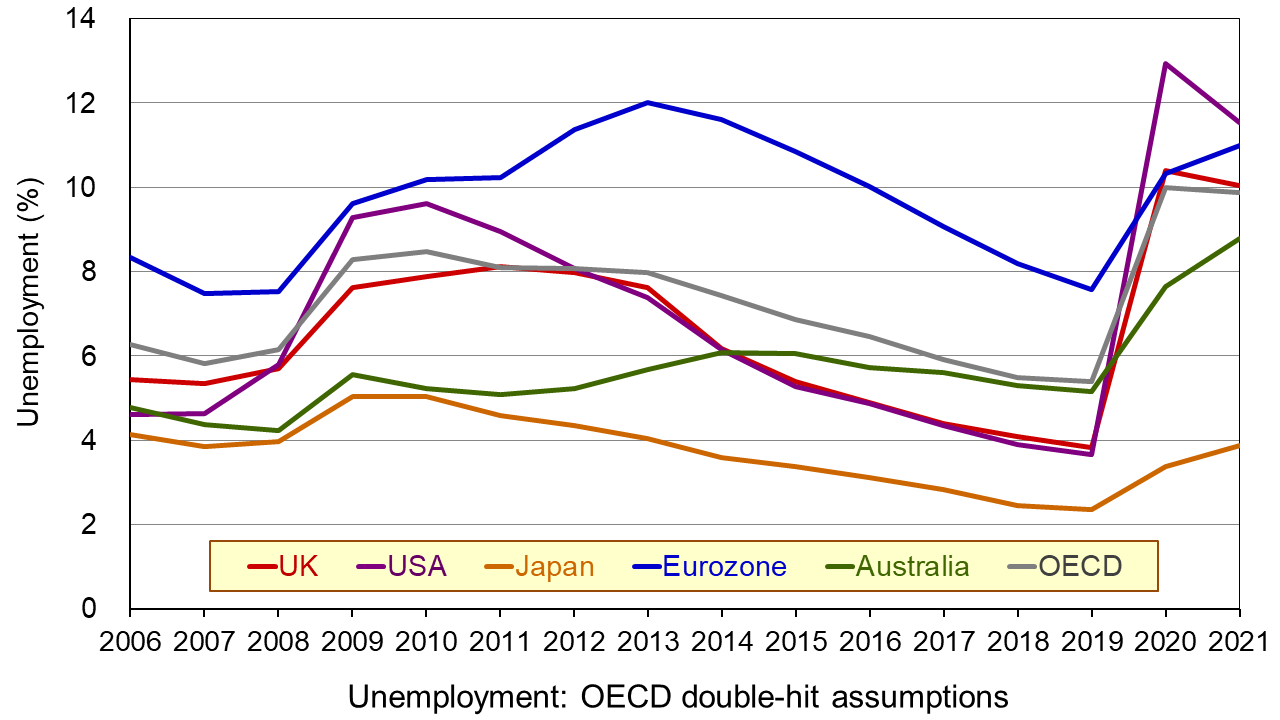
The second chart shows unemployment rates from 2006. The figures for 2020 and 2021 are OECD forecasts based on the double-hit assumption. You can clearly see the dramatic rise in unemployment in all the countries in 2020. In some cases it is forecast that there will be a further rise in 2021. (Click here for a PowerPoint of the chart.)
As the OECD states:
In both scenarios, the recovery, after an initial, rapid resumption of activity, will take a long time to bring output back to pre-pandemic levels, and the crisis will leave long-lasting scars – a fall in living standards, high unemployment and weak investment. Job losses in the most affected sectors, such as tourism, hospitality and entertainment, will particularly hit low-skilled, young, and informal workers.
But why have the forecasts got gloomier? There are both demand- and supply-side reasons.
Aggregate demand has fallen more dramatically than originally anticipated. Lockdowns have lasted longer in many countries than governments had initially thought, with partial lockdowns, which replace them, taking a long time to lift. With less opportunity for people to go out and spend, consumption has fallen and saving has risen. Businesses that have shut, some permanently, have laid off workers or they have been furloughed on reduced incomes. This too has reduced spending. Even when travel restrictions are lifted, many people are reluctant to take holidays at home and abroad and to use public transport for fear of catching the virus. This reluctance has been higher than originally anticipated. Again, spending is lower than before. Even when restaurants, bars and other public venues are reopened, most operate at less than full capacity to allow for social distancing. Uncertainty about the future has discouraged firms from investing, adding to the fall in demand.
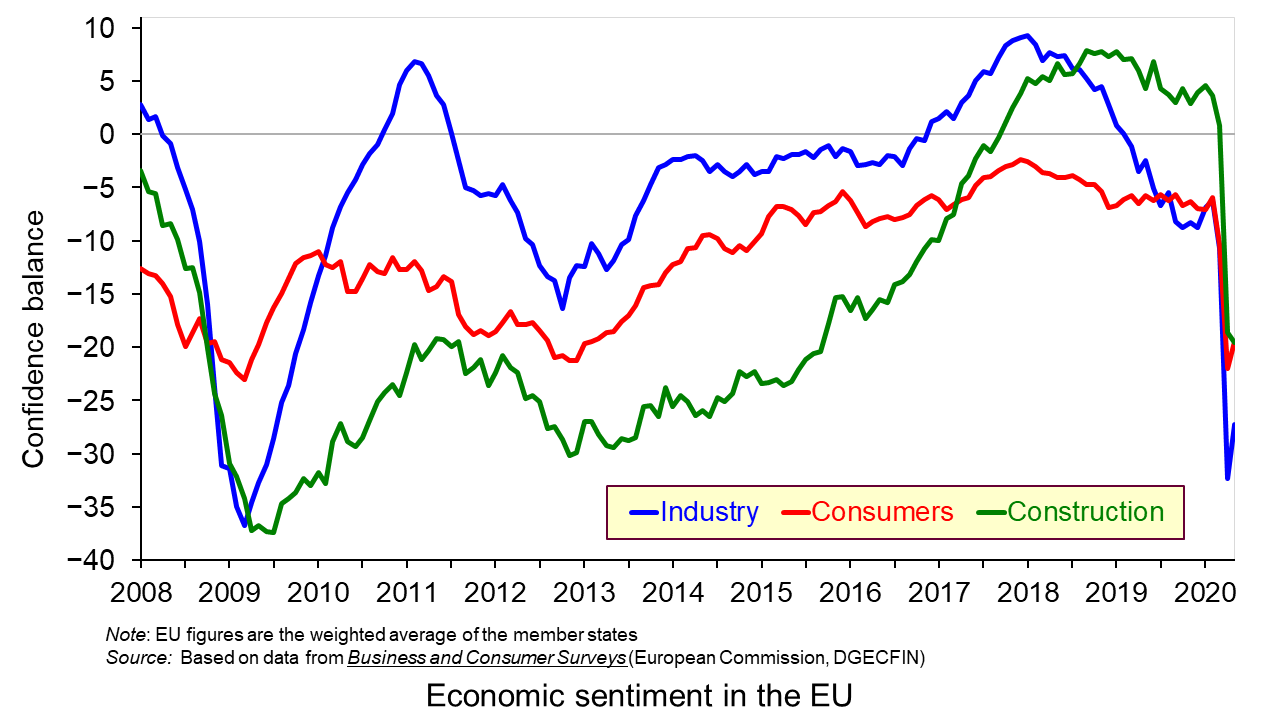
On the supply side, there has been considerable damage to capacity, with firms closing and both new and replacement investment being put on hold. Confidence in many sectors has plummeted as shown in the third chart which looks at business and consumer confidence in the EU. (Click here for a PowerPoint of the above chart.) Lack of confidence directly affects investment with both supply- and demand-side consequences.
Achieving a sustained recovery will require deft political and economic judgements by policymakers. What is more, people are increasingly calling for a different type of economy – one where growth is sustainable with less pollution and degradation of the environment and one where growth is more inclusive, where the benefits are shared more equally. As Angel Gurría, OECD Secretary-General, states in his speech launching the latest OECD Economic Outlook:
The aim should not be to go back to normal – normal was what got us where we are now.
Articles
OECD publications
Questions
- Why has the UK economy been particularly badly it by the Covid-19 pandemic?
- What will determine the size and timing of the ‘bounce back’?
- Why will the pandemic have “dire and long-lasting consequences for people, firms and governments”?
- Why have many people on low incomes faced harsher consequences than those on higher incomes?
- What are the likely environmental impacts of the pandemic and government measures to mitigate the effects?
 Pre-Covid 19, the climate change movement had gathered momentum with climate activist Greta Thunberg regularly in the news and people around the world striking in protest of inadequate government action on the climate crisis. However, now in a world overtaken by the pandemic, climate change is no longer at the centre and appears a more distant threat. The majority of the large climate change events due to take place this year have been delayed and policy announcements are aimed at supporting the current economic hardships. This is not surprising nor debatable, but there is a risk that, as Covid-19 dominates the news, policy and debates for a long time to come, this will overshadow any environmental initiatives that were due to be implemented.
Pre-Covid 19, the climate change movement had gathered momentum with climate activist Greta Thunberg regularly in the news and people around the world striking in protest of inadequate government action on the climate crisis. However, now in a world overtaken by the pandemic, climate change is no longer at the centre and appears a more distant threat. The majority of the large climate change events due to take place this year have been delayed and policy announcements are aimed at supporting the current economic hardships. This is not surprising nor debatable, but there is a risk that, as Covid-19 dominates the news, policy and debates for a long time to come, this will overshadow any environmental initiatives that were due to be implemented.
Governments around the globe are navigating their economies through the pandemic and starting to think about the future road to recovery. However, there is an argument that it doesn’t have to be a case of ‘either or’, as there is the potential for policies to address the Covid-19 crisis and climate change at the same time. How policy makers respond now could shape the fight against climate change for the future. One of the lessons from the pandemic is that quick responses to high impact risks are vital to reduce costs. With that in mind, and given the costs of climate change, it is arguable that now is the best time to address its challenges.
Climate change and Covid
 It is estimated that there was a total global loss of $3tn caused by natural disasters over the past decade. By 2050, cumulative damages from climate change are predicted to reach $8 trillion, impoverishing the world as a whole by 3% of GDP and the poorest regions by more. Climate activists argue that despite the economic consequences of climate change, the action taken by governments has been insufficient. In 2015, the then Bank of England governor, Mark Carney warned: ‘Once climate change becomes a defining issue for financial stability, it may already be too late.’
It is estimated that there was a total global loss of $3tn caused by natural disasters over the past decade. By 2050, cumulative damages from climate change are predicted to reach $8 trillion, impoverishing the world as a whole by 3% of GDP and the poorest regions by more. Climate activists argue that despite the economic consequences of climate change, the action taken by governments has been insufficient. In 2015, the then Bank of England governor, Mark Carney warned: ‘Once climate change becomes a defining issue for financial stability, it may already be too late.’
However, since the pandemic struck all over the world, there have been positive consequences for the environment. Pollution levels started dropping fast as airlines grounded fleets, car travel came to a stop and industries shut down. With 2.6bn people living under restrictions under their country’s lockdown, there has also been an impact on the environment, not just the spread of the virus. Given that the lockdowns across the world have come at huge social and human costs, is now not the time to ensure that these improvements for the environment are not just temporary but ignite long-term changes?
 Given the clear impacts and risks of Covid on peoples’ health, our ability to change our behaviour quickly has been striking. The importance of behaviour change has been brought to the centre and, arguably, it shows that we are capable of change when lives are at risk and are deemed more important than business-as-usual GDP growth. The application to climate change, however, is not as straightforward, as the costs to human lives are often viewed as a future problem.
Given the clear impacts and risks of Covid on peoples’ health, our ability to change our behaviour quickly has been striking. The importance of behaviour change has been brought to the centre and, arguably, it shows that we are capable of change when lives are at risk and are deemed more important than business-as-usual GDP growth. The application to climate change, however, is not as straightforward, as the costs to human lives are often viewed as a future problem.
Global cooperation
Dr Laure de Preux, Assistant Professor of Economics at Imperial College Business School, highlights the important role that cooperation across borders plays in the face of a global crisis like Coronavirus, and how that can be applied to the fight against climate change.
The big challenges the world is facing, including the climate change crisis, can only be dealt with efficiently through international cooperation. We cannot only act individually; the benefits of our actions are multiplied if integrated into a global strategy. In the case of COVID-19, social distancing measures can only be truly effective if they are adopted at a large scale.
World leaders are aware that their economies now face one of the most severe recessions in history as a consequence of the coronavirus restrictions. Governments are going to have to dedicate huge budgets to enable the economic activity to resume again. This presents a unique challenge, but also a massive opportunity for global cooperation. The question to be asked, therefore, is that if these stimulus packages are a one-off chance to transform the economy, how should the government spend it and what should be their focus? Should the recovery policies focus on creating a greener economy?
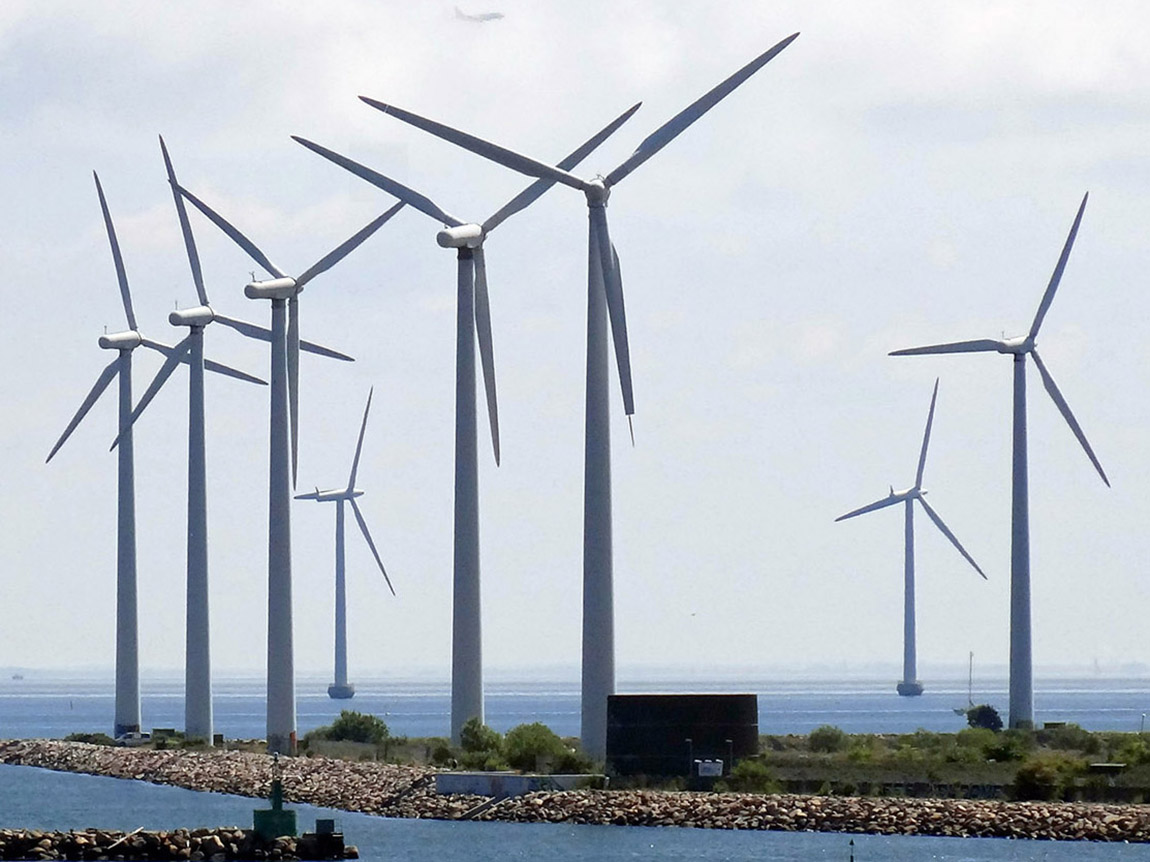 The European Union unveiled what it is calling the biggest ‘green’ stimulus package in history. Ursula von der Leyen, the European Commission president, told European Parliament members that this issue is about all nations and it is bigger than any one of them. The deputy Prime Minister of Spain, Teresa Ribera, states that there is a greater risk by not acting in this way. She argues that if the recovery is not green, then it will be nothing but a short-cut to solve the current problems rather than a true economic recovery.
The European Union unveiled what it is calling the biggest ‘green’ stimulus package in history. Ursula von der Leyen, the European Commission president, told European Parliament members that this issue is about all nations and it is bigger than any one of them. The deputy Prime Minister of Spain, Teresa Ribera, states that there is a greater risk by not acting in this way. She argues that if the recovery is not green, then it will be nothing but a short-cut to solve the current problems rather than a true economic recovery.
It is not just in Europe where the recovery has an environment focus. Joe Biden is believed to be planning a similarly huge green stimulus package for the US. The model echoes the vast investment projects of the New Deal that helped lift America out of the Great Depression in the 1930s.
There are sound economic reasons why politicians see green technology as a prudent investment. Renewable energy is now often cheaper than fossil fuels in large parts of the world and the technologies are proven and can be built at scale today. The argument for renewables providing a pathway for clean future growth is based on the logic of much of manufacturing – the more you produce, the cheaper it gets. However, China does not appear to have similar plans for their recovery. China produces almost a third of the world’s emissions, as much as the USA and the EU combined. At the annual National People’s Congress, there was no indication that the big expansion of coal-fired electricity generation would be reversed, even though it is also expanding the production of renewable energy. China expanded its coal-fired power stations as a key part of its stimulus package after the 2008 financial crisis.
Policy decisions
 The UK government receives ongoing pressure from energy companies. The boss of energy giant SSE, Alistair Phillips-Davies has warned that a failure to deal with climate change could eventually have a greater economic impact than coronavirus. SSE wants the UK government to encourage private investment in renewables by giving the green light to big new projects, such as hydrogen and carbon capture plants and boosting electric vehicles. Despite the impacts of climate change not being immediately felt in comparison to Covid-19, Phillips-Davies argues that a failure to deal with climate change could lead to great long-term impacts:
The UK government receives ongoing pressure from energy companies. The boss of energy giant SSE, Alistair Phillips-Davies has warned that a failure to deal with climate change could eventually have a greater economic impact than coronavirus. SSE wants the UK government to encourage private investment in renewables by giving the green light to big new projects, such as hydrogen and carbon capture plants and boosting electric vehicles. Despite the impacts of climate change not being immediately felt in comparison to Covid-19, Phillips-Davies argues that a failure to deal with climate change could lead to great long-term impacts:
While it is still too early to predict with confidence the full human, social and economic impact of coronavirus, we can say with certainty that significant investment will be needed to rebuild the UK economy in its wake.
It is clear that any pandemic-induced financial decisions made over the next 12 months will shape the global economy for the next decade. The full impact of the virus on climate change will be determined by the world’s stimulus measures adopted post-pandemic. Following the 2008 financial crisis, the energy-intensive stimulus measures that followed, particularly in China, boosted emissions. Therefore, if we are to meet the reduction in emissions target our response needs to be green, helping to shape a sustainable future. Dr Alex Koberle, of the Grantham Institute at Imperial College London, argues that Governments should take time to reflect, learn from past mistakes and redirect development towards a sustainable future.
Shouldn’t growth be given priority?
With 1.6 billion people working in the informal economy worldwide reckoned to be in immediate danger of losing their livelihoods (according to the International Labour Organization), is now the right time to be focusing on the climate? Industries such as airlines and car manufacturing are strategic industries, employing millions of people. Headlines of longer-term environmental targets will be given less importance than headlines of job losses. Recovery relies on the government finding ways to employ lots and lots of people. There is a close relationship between real GDP, employment and energy consumption. Therefore, any policies aimed at reducing greenhouse gas emissions, unless carefully directed, could reduce economic growth and employment for both less and more developed economies. Such policies would increase the cost of conventional energy sharply.
Critics of a green energy policy for recovery argue that investing in renewable energy ignores the adverse effects of reduced investment and higher energy costs in other sectors. By governments prioritising policy to focus on the environment, they could harm the ability of most people to improve their own circumstances, especially given the terrible economic shock caused by the lockdowns.
Conclusion
 With the majority of news in recent months providing little joy, there has been at least the positive impact on the environment. However, advocates say it not a cause for celebration and warn that any benefits are likely to be short lived. There have been some positive behavioural impacts but the true test will be what happens in the recovery phase. If the focus is returned to business as usual what happens to the targets actioned prior to Covid-19?
With the majority of news in recent months providing little joy, there has been at least the positive impact on the environment. However, advocates say it not a cause for celebration and warn that any benefits are likely to be short lived. There have been some positive behavioural impacts but the true test will be what happens in the recovery phase. If the focus is returned to business as usual what happens to the targets actioned prior to Covid-19?
The immediate priority of all governments right now is to control the pandemic and to save lives. As their policy interventions have an impact and economies start to emerge from this crisis, then there is an important debate to be had about how new investments can help create a cleaner, greener recovery. We have learnt from the current pandemic that changes can be made when consequences are imminent, however, climate change is a threat that doesn’t go away, and is arguably just as urgent. Solutions to both crises can be integrated into a coherent response to propel the global economy towards sustainable growth and increased resilience.
Articles
Letter
Questions
- Are government attempts to reduce the impact of climate change beneficial or harmful to UK firms?
- What policy instruments can the government use to increase economic activity?
- How does an increase in investment affect aggregate demand?
- What are the costs and benefits of economic growth?
- Why can climate change be described as a market failure?
 At its meeting on 6 May, the Bank of England’s Monetary Policy Committee decided to keep Bank Rate at 0.1%. Due to the significant impact of COVID-19 and the measures put in place to try to contain the virus, the MPC voted unanimously to keep Bank Rate the same.
At its meeting on 6 May, the Bank of England’s Monetary Policy Committee decided to keep Bank Rate at 0.1%. Due to the significant impact of COVID-19 and the measures put in place to try to contain the virus, the MPC voted unanimously to keep Bank Rate the same.
However, it decided not to launch a new stimulus programme, with the committee voting by a majority of 7-2 for the Bank to continue with the current programme of quantitative easing. This involves the purchase of £200 billion of government and sterling non-financial investment-grade corporate bonds, bringing the total stock of bonds held by the Bank to £645 billion.
The Bank forecast that the crisis will put the economy into its deepest recession in 300 years, with output plunging 30 per cent in the first half of the year.
Monetary policy and MPC
Monetary policy is the tool used by the UK’s central bank to influence how much money is in the economy and how much it costs to borrow. The Bank of England’s main monetary policy tools include setting the Bank Rate and quantitative easing (QE). Bank Rate is the interest rate charged to banks when they borrow money from the BoE. QE is the process of creating money digitally to buy corporate and government bonds.
The BoE’s Monetary Policy Committee (MPC) sets monetary policy to meet the 2% inflation target. Maintaining a low and stable inflation rate is good for the economy and it is the main monetary policy aim. However, the Bank also has to balance this target with the government’s other economic aims of sustaining growth and employment in the economy.
Actions taken by the MPC
It is challenging to respond to severe economic and financial disruption, with the UK economy looking unusually uncertain. Activity has fallen sharply since the beginning of the year and unemployment has risen markedly. The current rate of inflation, measured by the Consumer Price Index (CPI), declined to 1.5% in March and is likely to fall below 1% in the next few months. Household consumption has fallen by around 30% as consumer confidence has declined. Companies’ sales are expected to be around 45% lower than normal and business investment 50% lower.
In the current circumstances, and consistent with the MPC’s remit, monetary policy is aimed at supporting businesses and households through the crisis and limiting any lasting damage to the economy. The Bank has used both main monetary tools to fulfil its mandate and attempt to boost the economy amid the current lockdown. The Bank Rate was reduced to 0.1% in March, the lowest level in the Bank’s 325-year history and the current programme of QE was introduced in March.
What is next?
This extraordinary time has seen the outlook for the all global economies become uncertain.  The long-term outcome will depend critically on the evolution of the pandemic, and how governments, households and businesses respond to it. The Bank of England has stated that businesses and households will need to borrow to get through this period and is encouraging banks and building societies to increase their lending. Britain’s banks are warned that if they try to stem losses by restricting lending, they will make the situation worse. The Bank believes that the banks are strong enough to keep lending, which will support the economy and limit losses to themselves.
The long-term outcome will depend critically on the evolution of the pandemic, and how governments, households and businesses respond to it. The Bank of England has stated that businesses and households will need to borrow to get through this period and is encouraging banks and building societies to increase their lending. Britain’s banks are warned that if they try to stem losses by restricting lending, they will make the situation worse. The Bank believes that the banks are strong enough to keep lending, which will support the economy and limit losses to themselves.
In the short term, a bleak picture of the UK economy is suggested, with a halving in business investment, a near halving in business sales, a sharp rise in unemployment and households cutting their spending by a third. Despite its forecast that GDP could shrink by 14% for 2020, the Bank of England is forecasting a ‘V’ shaped recovery. In this scenario, the recovery in economic activity, once measures are softened, is predicted to be relatively rapid and inflation rises to around the 2 per cent target. However, this would be after a dip to 0.5% in 2021, before returning to the 2 per cent target the following year.
However, there are some suggestions that the Bank’s forecast for the long-term recovery is too optimistic. Yael Selfin, chief economist at KPMG UK, fears the UK economy could shrink even more sharply than the Bank of England has forecast.
Despite the stark numbers issued by the Bank of England today, additional pressure on the economy is likely. Some social distancing measures are likely to remain in place until we have a vaccine or an effective treatment for the virus, with people also remaining reluctant to socialise and spend. That means recovery is unlikely to start in earnest before sometime next year.
 There are also additional factors that could dampen future productivity, such as the impact on supply chains, with ‘just-in-time’ operations potentially being a thing of the past.
There are also additional factors that could dampen future productivity, such as the impact on supply chains, with ‘just-in-time’ operations potentially being a thing of the past.
There is also the ongoing issue of Brexit. This is a significant downside risk as the probability of a smooth transition to a comprehensive free-trade agreement with the EU in January is relatively small. This will only increase uncertainty for businesses along with the prospect of increased trade frictions next year.
Conclusion
The predictions from the Bank of England are based on many assumptions, one of which is that the economy will only be gradually released from lockdown. Its numbers contain the expectations that consumer and worker behaviour will change significantly, and continue for some time, with forms of voluntary social distancing. On the other hand, Mr Bailey expects the recovery to be much faster than seen with the financial crisis a decade ago. However, again this is based on the assumption that measures put in place from the public health side prevent a second wave of the virus.
It also assumes that the supply-side effects on the economy will be limited in the long run. Many economists disagree, arguing that the ‘scarring effects’ of the lockdown may be substantial. These include lower rates of investment, innovation and start ups and the deskilling effects on labour. They also include the businesses that have gone bankrupt and the dampening effect on consumer and business confidence. Finally, with a large increase in lending to tide firms over the crisis, many will face problems of debt, which will dampen investment.
The Bank of England does recognise these possible scarring effects. Specifically, it warns of the danger of a rise in equilibrium unemployment:
It is possible that the rise in unemployment could prove more persistent than embodied in the scenario, for example if companies are reluctant to hire until they are sure about the robustness of the recovery in demand. It is also possible that any rise in unemployment could lead to an increase in the long‑term equilibrium rate of unemployment. That might happen if the skills of the unemployed do not increase to the same extent as they would if they were working, for example, or even erode over time.
What is certain, however, is that the long-term picture will only become clearer when we start to come out of the crisis. Bailey implied that the Bank is taking a wait-and-see approach for now, waiting on the UK government to shed some light about easing of lockdown measures before taking any further action with regards to QE. The MPC will continue to monitor the situation closely and, consistent with its remit, stands ready to take further action as necessary to support the economy and ensure a sustained return of inflation to the 2% target. Paul Dales, chief UK economist at Capital Economics, suggested that the central bank is signalling that ‘more QE is coming, if not in June, then in August’.
Articles
Bank of England publication
Questions
- How could the BoE use monetary policy to boost the economy?
- Explain how changes in interest rates affect aggregate demand.
- Define and explain quantitative easing (QE).
- How might QE help to stimulate economic growth?
- How is the pursuit of QE likely to affect the price of government bonds? Explain.
- Evaluate the extent to which monetary policy is able to stimulate the economy and achieve price stability.
 Is there a ‘magic money tree’? Is it desirable for central banks to create money to finance government deficits?
Is there a ‘magic money tree’? Is it desirable for central banks to create money to finance government deficits?  ‘Modern Monetary Theory‘ challenges these arguments. Advocates of the theory support the use of higher deficits financed by monetary expansion if the money is spent on things that increase potential output as well as actual output. Examples include spending on R&D, education, infrastructure, health and housing.
‘Modern Monetary Theory‘ challenges these arguments. Advocates of the theory support the use of higher deficits financed by monetary expansion if the money is spent on things that increase potential output as well as actual output. Examples include spending on R&D, education, infrastructure, health and housing.  Modern Monetary Theory explained by Stephanie Kelton
Modern Monetary Theory explained by Stephanie Kelton Demystifying Modern Monetary Theory
Demystifying Modern Monetary Theory Boris Johnson gave a speech on 30 June outlining his government’s approach to recovery from the sharpest recession on record. With the slogan ‘Build, build, build’, he said that infrastructure projects were the key to stimulating the economy. Infrastructure spending is a classic Keynesian response to recession as it stimulates aggregate demand allowing slack to be taken up, while also boosting aggregate supply, thereby allowing recovery in output while increasing potential national income.
Boris Johnson gave a speech on 30 June outlining his government’s approach to recovery from the sharpest recession on record. With the slogan ‘Build, build, build’, he said that infrastructure projects were the key to stimulating the economy. Infrastructure spending is a classic Keynesian response to recession as it stimulates aggregate demand allowing slack to be taken up, while also boosting aggregate supply, thereby allowing recovery in output while increasing potential national income. There was some debate as to whether the New Deal could be classed as ‘Keynesian’. Officially, the administration was concerned to achieve a balanced budget. However, it had a separate ’emergency budget’, from which New Deal spending was financed. According to estimates by the Federal Reserve Bank of St Louis, the total extra spending amounted to nearly 40% of US GDP as it was in 1929.
There was some debate as to whether the New Deal could be classed as ‘Keynesian’. Officially, the administration was concerned to achieve a balanced budget. However, it had a separate ’emergency budget’, from which New Deal spending was financed. According to estimates by the Federal Reserve Bank of St Louis, the total extra spending amounted to nearly 40% of US GDP as it was in 1929. Policy should thus focus on job creation, especially in those sectors likely to experience the largest rise in unemployment. Such sectors include non-food retail, hospitality (pubs, restaurants, hotels, etc.), public transport, the arts, entertainment and leisure and a range of industries servicing these sectors. What is more, many of the people working in these sectors are young and low paid. Many will find it difficult to move to jobs elsewhere – partly because of a lack of qualifications and partly because of a lack of alternative jobs. The rising unemployment will raise inequality.
Policy should thus focus on job creation, especially in those sectors likely to experience the largest rise in unemployment. Such sectors include non-food retail, hospitality (pubs, restaurants, hotels, etc.), public transport, the arts, entertainment and leisure and a range of industries servicing these sectors. What is more, many of the people working in these sectors are young and low paid. Many will find it difficult to move to jobs elsewhere – partly because of a lack of qualifications and partly because of a lack of alternative jobs. The rising unemployment will raise inequality. Three international agencies, the IMF, the European Commission and the OECD, all publish six-monthly forecasts for a range of countries. As each agency’s forecasts have been published this year, so the forecasts for economic growth and other macroeconomic indicators, such as unemployment, have got more dire.
Three international agencies, the IMF, the European Commission and the OECD, all publish six-monthly forecasts for a range of countries. As each agency’s forecasts have been published this year, so the forecasts for economic growth and other macroeconomic indicators, such as unemployment, have got more dire. 


 Pre-Covid 19, the climate change movement had gathered momentum with climate activist Greta Thunberg regularly in the news and people around the world striking in protest of inadequate government action on the climate crisis. However, now in a world overtaken by the pandemic, climate change is no longer at the centre and appears a more distant threat. The majority of the large climate change events due to take place this year have been delayed and policy announcements are aimed at supporting the current economic hardships. This is not surprising nor debatable, but there is a risk that, as Covid-19 dominates the news, policy and debates for a long time to come, this will overshadow any environmental initiatives that were due to be implemented.
Pre-Covid 19, the climate change movement had gathered momentum with climate activist Greta Thunberg regularly in the news and people around the world striking in protest of inadequate government action on the climate crisis. However, now in a world overtaken by the pandemic, climate change is no longer at the centre and appears a more distant threat. The majority of the large climate change events due to take place this year have been delayed and policy announcements are aimed at supporting the current economic hardships. This is not surprising nor debatable, but there is a risk that, as Covid-19 dominates the news, policy and debates for a long time to come, this will overshadow any environmental initiatives that were due to be implemented. It is estimated that there was a total global loss of $3tn caused by natural disasters over the past decade. By 2050, cumulative damages from climate change are predicted to reach $8 trillion, impoverishing the world as a whole by 3% of GDP and the poorest regions by more. Climate activists argue that despite the economic consequences of climate change, the action taken by governments has been insufficient. In 2015, the then Bank of England governor, Mark Carney warned: ‘Once climate change becomes a defining issue for financial stability, it may already be too late.’
It is estimated that there was a total global loss of $3tn caused by natural disasters over the past decade. By 2050, cumulative damages from climate change are predicted to reach $8 trillion, impoverishing the world as a whole by 3% of GDP and the poorest regions by more. Climate activists argue that despite the economic consequences of climate change, the action taken by governments has been insufficient. In 2015, the then Bank of England governor, Mark Carney warned: ‘Once climate change becomes a defining issue for financial stability, it may already be too late.’  Given the clear impacts and risks of Covid on peoples’ health, our ability to change our behaviour quickly has been striking. The importance of behaviour change has been brought to the centre and, arguably, it shows that we are capable of change when lives are at risk and are deemed more important than business-as-usual GDP growth. The application to climate change, however, is not as straightforward, as the costs to human lives are often viewed as a future problem.
Given the clear impacts and risks of Covid on peoples’ health, our ability to change our behaviour quickly has been striking. The importance of behaviour change has been brought to the centre and, arguably, it shows that we are capable of change when lives are at risk and are deemed more important than business-as-usual GDP growth. The application to climate change, however, is not as straightforward, as the costs to human lives are often viewed as a future problem.  The European Union unveiled what it is calling the biggest ‘green’ stimulus package in history. Ursula von der Leyen, the European Commission president, told European Parliament members that this issue is about all nations and it is bigger than any one of them. The deputy Prime Minister of Spain, Teresa Ribera, states that there is a greater risk by not acting in this way. She argues that if the recovery is not green, then it will be nothing but a short-cut to solve the current problems rather than a true economic recovery.
The European Union unveiled what it is calling the biggest ‘green’ stimulus package in history. Ursula von der Leyen, the European Commission president, told European Parliament members that this issue is about all nations and it is bigger than any one of them. The deputy Prime Minister of Spain, Teresa Ribera, states that there is a greater risk by not acting in this way. She argues that if the recovery is not green, then it will be nothing but a short-cut to solve the current problems rather than a true economic recovery.  The UK government receives ongoing pressure from energy companies. The boss of energy giant SSE, Alistair Phillips-Davies has warned that a failure to deal with climate change could eventually have a greater economic impact than coronavirus. SSE wants the UK government to encourage private investment in renewables by giving the green light to big new projects, such as hydrogen and carbon capture plants and boosting electric vehicles. Despite the impacts of climate change not being immediately felt in comparison to Covid-19, Phillips-Davies argues that a failure to deal with climate change could lead to great long-term impacts:
The UK government receives ongoing pressure from energy companies. The boss of energy giant SSE, Alistair Phillips-Davies has warned that a failure to deal with climate change could eventually have a greater economic impact than coronavirus. SSE wants the UK government to encourage private investment in renewables by giving the green light to big new projects, such as hydrogen and carbon capture plants and boosting electric vehicles. Despite the impacts of climate change not being immediately felt in comparison to Covid-19, Phillips-Davies argues that a failure to deal with climate change could lead to great long-term impacts:  With the majority of news in recent months providing little joy, there has been at least the positive impact on the environment. However, advocates say it not a cause for celebration and warn that any benefits are likely to be short lived. There have been some positive behavioural impacts but the true test will be what happens in the recovery phase. If the focus is returned to business as usual what happens to the targets actioned prior to Covid-19?
With the majority of news in recent months providing little joy, there has been at least the positive impact on the environment. However, advocates say it not a cause for celebration and warn that any benefits are likely to be short lived. There have been some positive behavioural impacts but the true test will be what happens in the recovery phase. If the focus is returned to business as usual what happens to the targets actioned prior to Covid-19? At its meeting on 6 May, the Bank of England’s Monetary Policy Committee
At its meeting on 6 May, the Bank of England’s Monetary Policy Committee  There are also additional factors that could dampen future productivity, such as the impact on supply chains, with ‘just-in-time’ operations potentially being a thing of the past.
There are also additional factors that could dampen future productivity, such as the impact on supply chains, with ‘just-in-time’ operations potentially being a thing of the past.